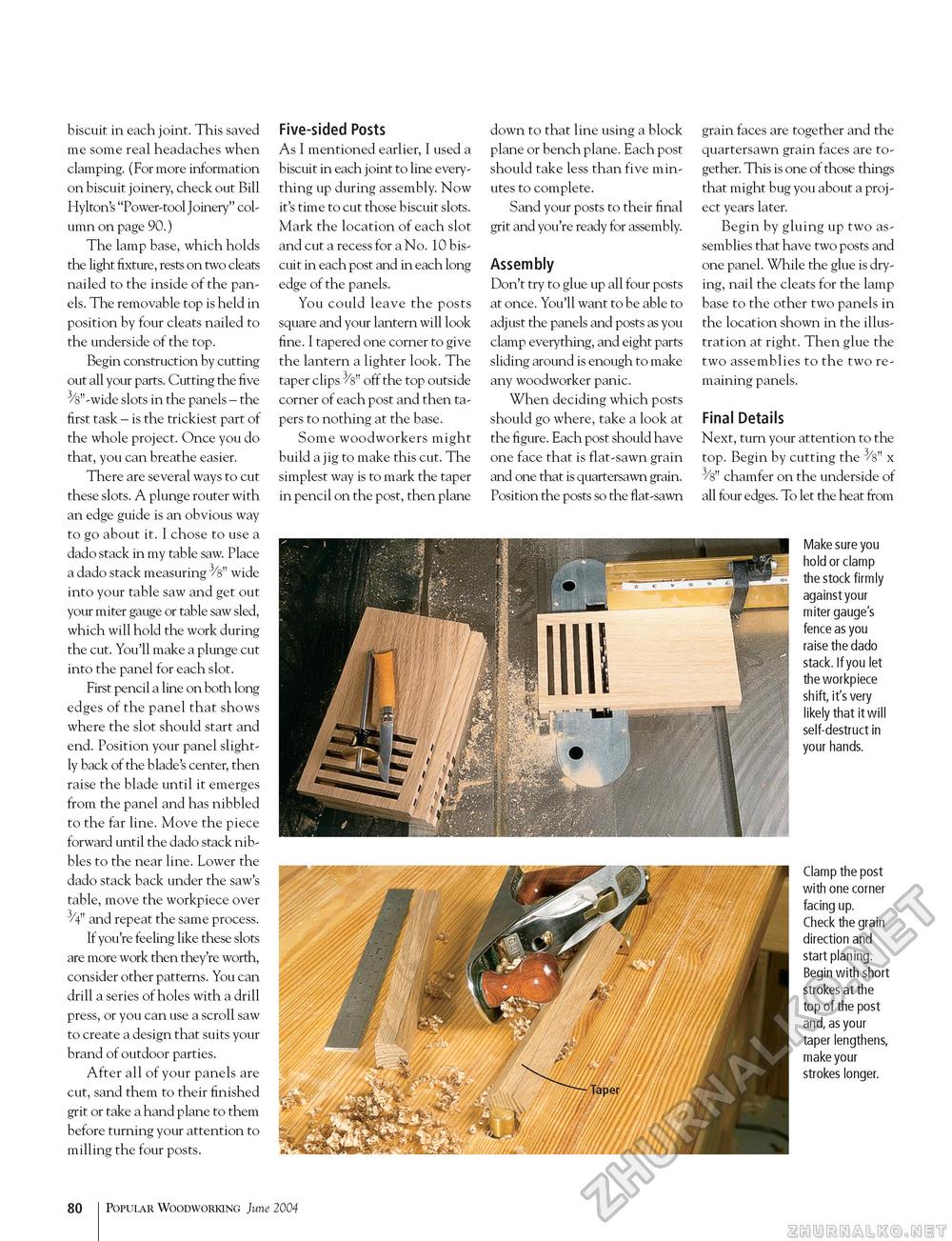Popular Woodworking 2004-06 № 141, страница 82
biscuit in each joint. This saved me some real headaches when clamping. (For more information on biscuit joinery, check out Bill Hylton's "Power-tool Joinery" column on page 90.) The lamp base, which holds the light fixture, rests on two cleats nailed to the inside of the panels. The removable top is held in position by four cleats nailed to the underside of the top. Begin construction by cutting out all your parts. Cutting the five 3/8"-wide slots in the panels - the first task - is the trickiest part of the whole project. Once you do that, you can breathe easier. There are several ways to cut these slots. A plunge router with an edge guide is an obvious way to go about it. I chose to use a dado stack in my table saw. Place a dado stack measuring 3/8" wide into your table saw and get out your miter gauge or table saw sled, which will hold the work during the cut. You'll make a plunge cut into the panel for each slot. First pencil a line on both long edges of the panel that shows where the slot should start and end. Position your panel slightly back of the blade's center, then raise the blade until it emerges from the panel and has nibbled to the far line. Move the piece forward until the dado stack nibbles to the near line. Lower the dado stack back under the saw's table, move the workpiece over 3/4" and repeat the same process. If you're feeling like these slots are more work then they're worth, consider other patterns. You can drill a series of holes with a drill press, or you can use a scroll saw to create a design that suits your brand of outdoor parties. After all of your panels are cut, sand them to their finished grit or take a hand plane to them before turning your attention to milling the four posts. Five-sided Posts As I mentioned earlier, I used a biscuit in each joint to line everything up during assembly. Now it's time to cut those biscuit slots. Mark the location of each slot and cut a recess for a No. 10 biscuit in each post and in each long edge of the panels. You could leave the posts square and your lantern will look fine. I tapered one corner to give the lantern a lighter look. The taper clips 3/8" off the top outside corner of each post and then tapers to nothing at the base. Some woodworkers might build a jig to make this cut. The simplest way is to mark the taper in pencil on the post, then plane down to that line using a block plane or bench plane. Each post should take less than five minutes to complete. Sand your posts to their final grit and you're ready for assembly. Assembly Don't try to glue up all four posts at once. You'll want to be able to adjust the panels and posts as you clamp everything, and eight parts sliding around is enough to make any woodworker panic. When deciding which posts should go where, take a look at the figure. Each post should have one face that is flat-sawn grain and one that is quartersawn grain. Position the posts so the flat-sawn grain faces are together and the quartersawn grain faces are together. This is one of those things that might bug you about a project years later. Begin by gluing up two assemblies that have two posts and one panel. While the glue is drying, nail the cleats for the lamp base to the other two panels in the location shown in the illustration at right. Then glue the two assemblies to the two remaining panels. Final Details Next, turn your attention to the top. Begin by cutting the 3/8" x 3/8" chamfer on the underside of all four edges. To let the heat from Make sure you hold or clamp the stock firmly against your miter gauge's fence as you raise the dado stack. If you let the workpiece shift, it's very likely that it will self-destruct in your hands. Clamp the post with one corner facing up. Check the grain direction and start planing. Begin with short strokes at the top of the post and, as your taper lengthens, make your strokes longer. 80 Popular Woodworking June 2004 |








